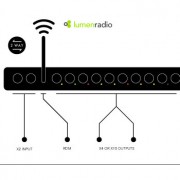LED Lighting Challenges in Film and TV, Dan Stanton, Director at EMP Designs
Flicker – a familiar issue for film & TV. As LED lighting & camera technology boom, what is the root of the flicker problem and how can it be resolved?
LED lighting has been glowing increasingly into our everyday lives for years. The benefits of energy efficiency, longevity and instant light have reached a full range of products and industries. But one sector where the use of LEDs has recently burgeoned, is that of TV and film.
Whilst offering many advantages such as flexibility, portability and low temperatures, the use of LEDs in filming is not without its problems. In a film environment, lighting is crucial and needs to be controlled and managed to precise yet highly diverse requirements.
The flicker issue is one well-known to the film industry, even before the rise of LEDs. As camera technology advances, higher speed shooting has made flicker issues ever more prevalent.
The control systems used for LED lighting are critical as they can have a significant impact on the quality of the filming. If the system is of low quality or nor tailored to the precise scope, size and shape of a particular light, then many visual issues can occur. With such a range of lighting available, the demands on generic controllers are complex.
The most economical way to control LEDs, and particularly effective at dimming them, is via a method known as Pulse Width Modulation (PWM). It involves LED lights being turned on and off very quickly. Basically, it uses a square type electrical wave whereby the more time the light is on within a given period, the brighter it will be, the less time it’s on, the dimmer. This topology is widely used in a number of controllers in the industry.
This is where the frequency that LEDs are driven at (and turned on and off at) becomes crucial. The frequency needs to be high enough that the light appears constant and the ‘on and off’ switching is not visible. This in itself is manageable, but of course cameras themselves shoot a number of still frames per second, whether via a mechanical shutter or digital CMOS scan with a software shutter. This brings another range of frequencies to the equation and it can be highly problematic synchronising the frequencies of the camera shots with those of the LED lighting. If not synchronised then a distortion occurs that shows in the film as a flicker or a scrolling effect.
Some companies have attempted to combat the distortions by increasing the frequency of the LED control higher and higher. But there are limits and as the speed increases the LED and control efficiencies diminish causing many arrays such as LED tape to start to underperform.
There are also constant current solutions which with a consistent linear current can work incredibly well, but only if the controller is built with knowledge of the full specifications of the light it will be connected to and this is rarely the case. This is combined with the fact that constant current solutions are larger and have more components in an industry that is highly sensitive to space economics and constantly demanding compact, discreet control systems.
As cameras continually upgrade to higher scan rates, the PWM principle will simply no longer be adequate. We are asking more and more of the technology and no existing system currently deals with the all issues. As such EMP is researching and applying new technologies to LED control to develop flexible solutions that resolve frequency and distortion issues, whilst maintaining full high resolution brightness control and dynamic, instant, response. It’s an exciting area to be working in, and we are looking forward a flicker free future.


